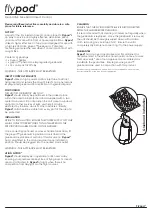
Maintenance—4 8 5 /R 4 8 5 Service
INVERTER BOARD REMOVAL
W A R N I N G
Line A C and stored DC potentials are present on the
Inverter and Transformer boards. The stored DC
remains long a fte r the instrum ent is disconnected
from the pow er line. V erify th a t the line cord is
disconnected and that the line storage capacitors,
C1822 and C1823, are com pletely discharged before
attem pting any repairs (w a it three minutes after
DS1824, located under the m etal shield, stops
flashing). The stored DC can be measured between
TP1834 (POS) and TP1844 (NEG). I f manual dis
charge is necessary use a 1.5 k£ l, 2 W insulated
resistor w ith insulated leads.
USE EXTR EM E
CAUTION.
a. Remove the metal protective shield (4 screws).
b.
Remove the 4 shield mounting standoffs so that the
board can come straight out.
c.
Remove the comb connector and unplug the 2 pin
cable.
d.
Remove the 4 screws holding the Inverter board and
the 4 screws holding the insulating material of the two large
transistors at the rear of the board.
e. To repair the Inverter board or gain access to the
Transformer board, lift the Inverter board up and turn it to
one side. It is not necessary to unsolder the primary leads.
f. For complete removal of the Inverter board, unsolder
the three primary leads.
g. To install the board, reverse the procedure.
Semiconductor Replacement. Semiconductors should
not be replaced unless actually defective. If removed from
their sockets during routine maintenance, return them to
their original sockets. .Unnecessary replacement of semi
conductors may affect the calibration of this instrument.
When semiconductors are replaced, check the operation of
the part of the instrument which may be affected.
POWER switch must be turned o f f before removing
o r replacing semiconductors.
Replacement semiconductors should be of the original
type or a direct replacement. Fig. 4-1 shows the lead
configuration of the semiconductors used in this instru
ment. Some plastic case transistors have lead configurations
which do not agree with those shown here. If a replacement
transistor is made by a different manufacturer than the
original, check the manufacturer's basing diagram for
correct basing. A ll transistor sockets in this instrument are
wired for the standard basing as used for metal-cased
transistors. Transistors which have heat radiators or are
mounted on the chassis use silicone grease to increase heat
transfer. Replace the silicone grease when replacing these
transistors.
W A R N I N G
Handle silicone grease w ith care. A v o id getting
silicone grease in the eyes. Wash hands thoroughly
a fte r use.
An extracting tool should be used to remove the 14- and
16-pin integrated circuits to prevent damage to the pins.
This tool is available from Tektronix, Inc. Order Tektronix
Part No. 003-0619-00. If an extracting tool is not available
when removing one of these integrated circuits, pull slowly
and evenly on both ends of the device. T ry to avoid having
one end of the integrated circuit disengage from the socket
before the other, as this may damage the pins.
Interconnecting Pin Replacement. The following infor
mation provides the replacement procedure for the various
types of interconnecting methods.
A. CIRCUIT-BOARD PINS.
NOTE
A circuit-board replacement k it including necessary
tools, instructions and replacement pins is available
from Tektronix, Inc. Order T ektronix Part No.
040-0542-00.
To replace a pin which is mounted on a circuit board,
first disconnect any pin connectors. Then, unsolder the
damaged pin and pull it out of the circuit board w ith a pair
4-14
®
Summary of Contents for 485
Page 3: ...485 R485 rviice T h 5 0 Oscil oscope ...
Page 74: ...Rackmounting 485 R485 Service 6 6 ...
Page 128: ...485 R485 Service MAR 1979 5 m V B A L ADJ ...
Page 152: ... 0 iT s i ...
Page 164: ...2S2 n eKn s e s 5 4 85 Os c illo sc o p e REV F A U S 1 9 7 7 I 1 9 3 5B POWER SUPPLY 773 ...
Page 178: ......
Page 179: ...485 R485 OSCILLOSCOPE REV D MAR 1977 ...
Page 184: ...REV C MAR 1976 485 R485 OSCILLOSCOPE ...
Page 197: ......
















































